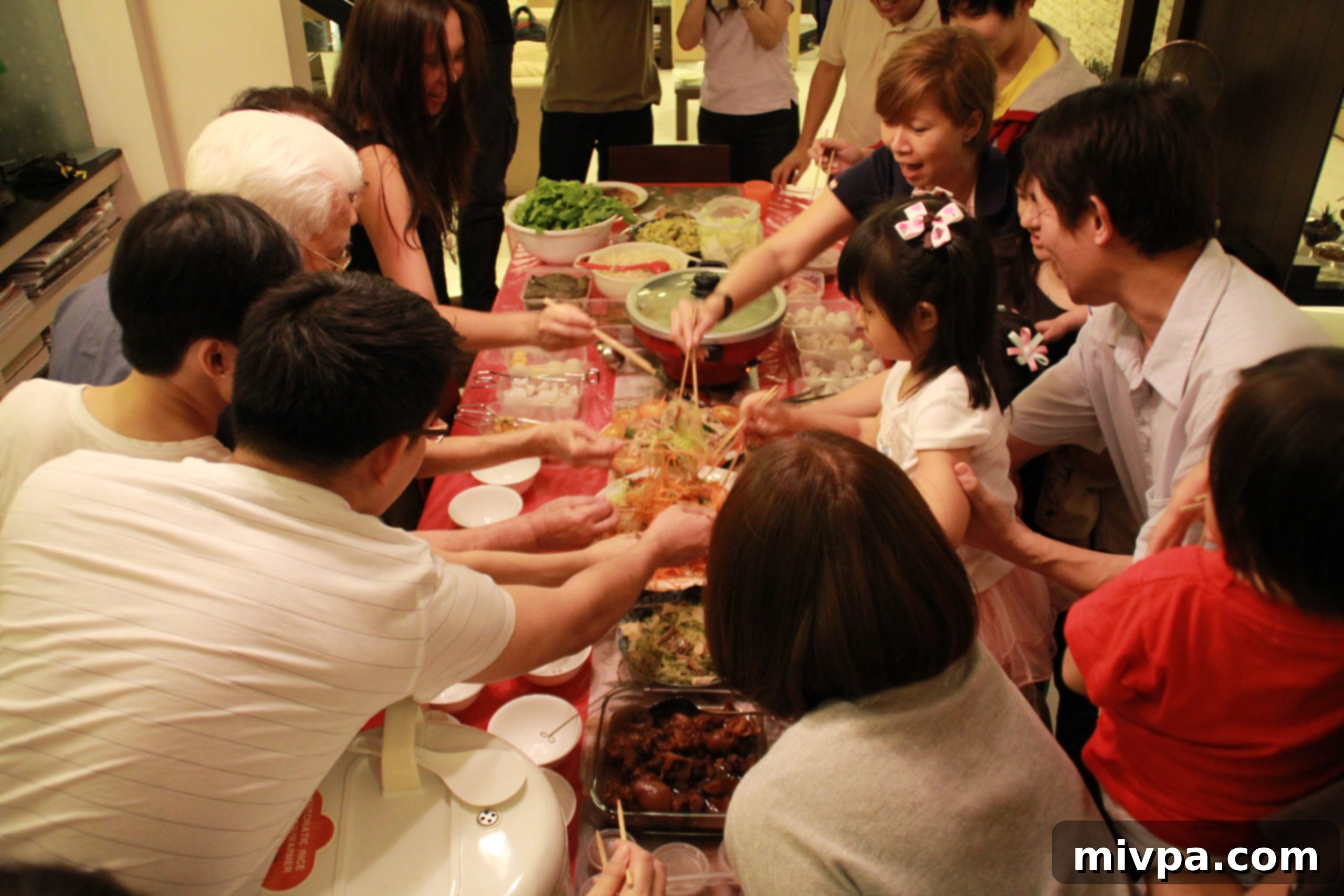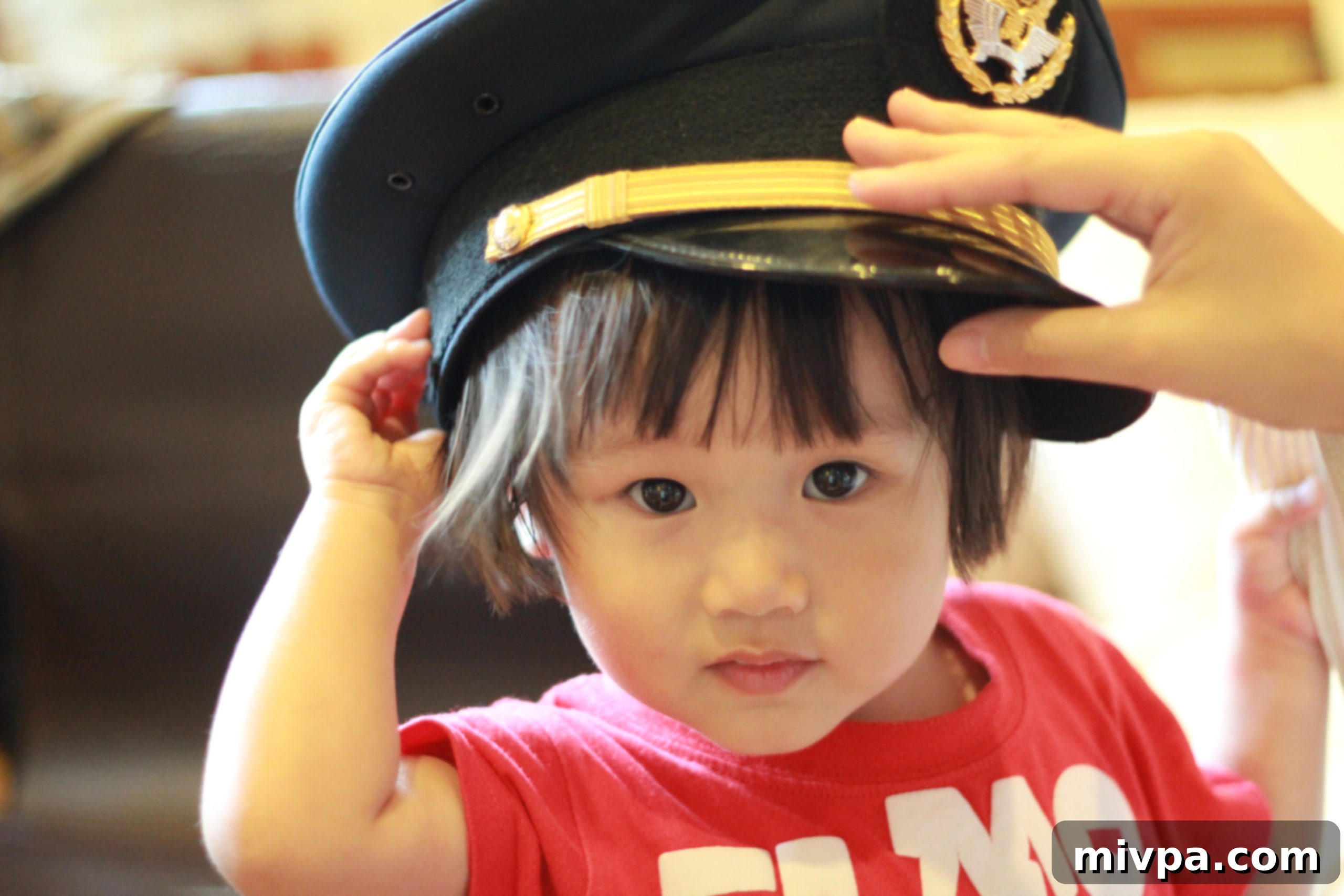A Heartwarming Chinese New Year Reunion: Culinary Traditions, Family Joy, and the Significance of Yu Sheng in Singapore
The air was thick with anticipation, a blend of familiar aromas, and the faint hum of excited chatter. Despite the lingering effects of jet lag and a persistent flutter of nerves, Sunday night’s family reunion dinner unfolded as a resounding success! A collective sigh of relief, coupled with profound gratitude, washed over me. This wasn’t just any meal; it marked my inaugural culinary challenge here in Singapore, a gastronomic trial by fire for my most discerning panel of judges – my beloved extended family members. True to form, they offered an array of insightful, albeit playfully critical, feedback on potential enhancements. Yet, the overwhelming sentiment was one of immense joy and connection, a testament to the special bond we share whenever we gather.
For me, personally, taking the reins and preparing this reunion dinner was an incredibly fulfilling experience. It transcended mere cooking; it was an act of love, tradition, and a tangible expression of my role within the family. It allowed me to weave my culinary passion into the vibrant tapestry of our shared heritage, particularly during such an auspicious occasion.
The Enduring Significance of Chinese New Year Reunion Dinners
The “Reunion Dinner” stands as a cornerstone tradition for most Chinese families, a sacred ritual observed on Chinese New Year’s Eve. It’s a time when extended family members, often traveling from afar, converge to partake in a lavish feast of meticulously prepared home-cooked dishes. This culinary spread typically features a steamboat – a bubbling hot pot where an assortment of meats, fresh seafood, and crisp vegetables are cooked communally in a rich, aromatic soup stock – and the iconic “Yu Sheng,” or “Prosperity Toss.” Yu Sheng, a vibrant salad-like dish, traditionally comprises delicate strips of raw fish (most commonly salmon), artfully mixed with an array of shredded fresh vegetables, fragrant nuts, crisp crackers, and a medley of delectable sauces and condiments. Each ingredient in Yu Sheng carries deep symbolic meaning, collectively representing abundance, prosperity, vigor, and good fortune, making it an indispensable centerpiece for all Chinese New Year gatherings.
The profound importance of the reunion dinner stems from its role as a moment of reconnection. After a year, or sometimes even longer, spent apart due to work, studies, or life’s various demands, loved ones and family members reunite under one roof. This tradition holds an especially cherished place in our hearts, symbolizing unity, gratitude, and the enduring strength of familial bonds. It’s a moment to reflect on the past year, share aspirations for the new one, and reinforce the ties that bind us. Hence, my initial nervousness, coupled with a surge of excitement as I contributed for the very first time, felt entirely natural. My deepest desire was for the meal to be exceptional, for every family member to savor each bite, and to finally apply my culinary skills in Singapore, my cherished homeland.
My Culinary Journey: From Jet Lag to Feast Preparation
Jet lag proved to be an unexpected ally, stirring me awake at an unusually early 6 AM on Sunday morning. Rather than fighting it, I embraced the early start, deciding it was the perfect opportunity to begin baking a moist carrot cake with luscious cream cheese frosting for dessert. The fragrant aroma of cinnamon and spices soon filled the kitchen, a comforting start to a momentous day. Once the cake was safely out of the oven and cooling, the subsequent hours seemed to vanish in a delightful blur – church services, a quick lunch, and then a swift return home to intensify preparations for the evening’s grand dinner.
My contributions extended beyond dessert. I meticulously prepared a batch of crispy Rosti, a savory potato dish designed to complement the steamboat with its delightful texture and flavor. Alongside this, I assembled a refreshing tropical fruit salad, bursting with the vibrant colors and sweet tang of exotic fruits. Teamwork was key, and I eagerly joined my mother and grandmother in crafting a traditional and intricate dish: a stir-fry featuring tender leek, earthy mushrooms, savory pork, and delicate fish maw, among the many other exquisite dishes my mother had expertly prepared. The kitchen was a hive of activity, a symphony of chopping, stirring, and simmering, each action a step closer to the impending celebration.
The Joyful Arrival of Guests and Adorable Moments
As the evening drew closer, the doorbell began to chime, signaling the much-anticipated arrival of our guests. One by one, familiar faces filled the home, bringing with them warmth, laughter, and an palpable sense of collective happiness. Among the wonderful gathering, there was one guest who unequivocally stole the show and captured every heart in the room: my two-year-old baby cousin, En Tong.
With her irresistibly chubby cheeks and an angelic face that radiated pure innocence, En Tong effortlessly charmed us all. Her impromptu dancing antics, full of uninhibited joy, her impossibly adorable smile that could melt even the sternest of hearts, and her spirited rendition of PSY’s iconic “Gangnam Style” dance were simply captivating. She moved with an infectious energy, embodying the unbridled spirit of childhood and adding a layer of pure, unadulterated delight to our gathering.
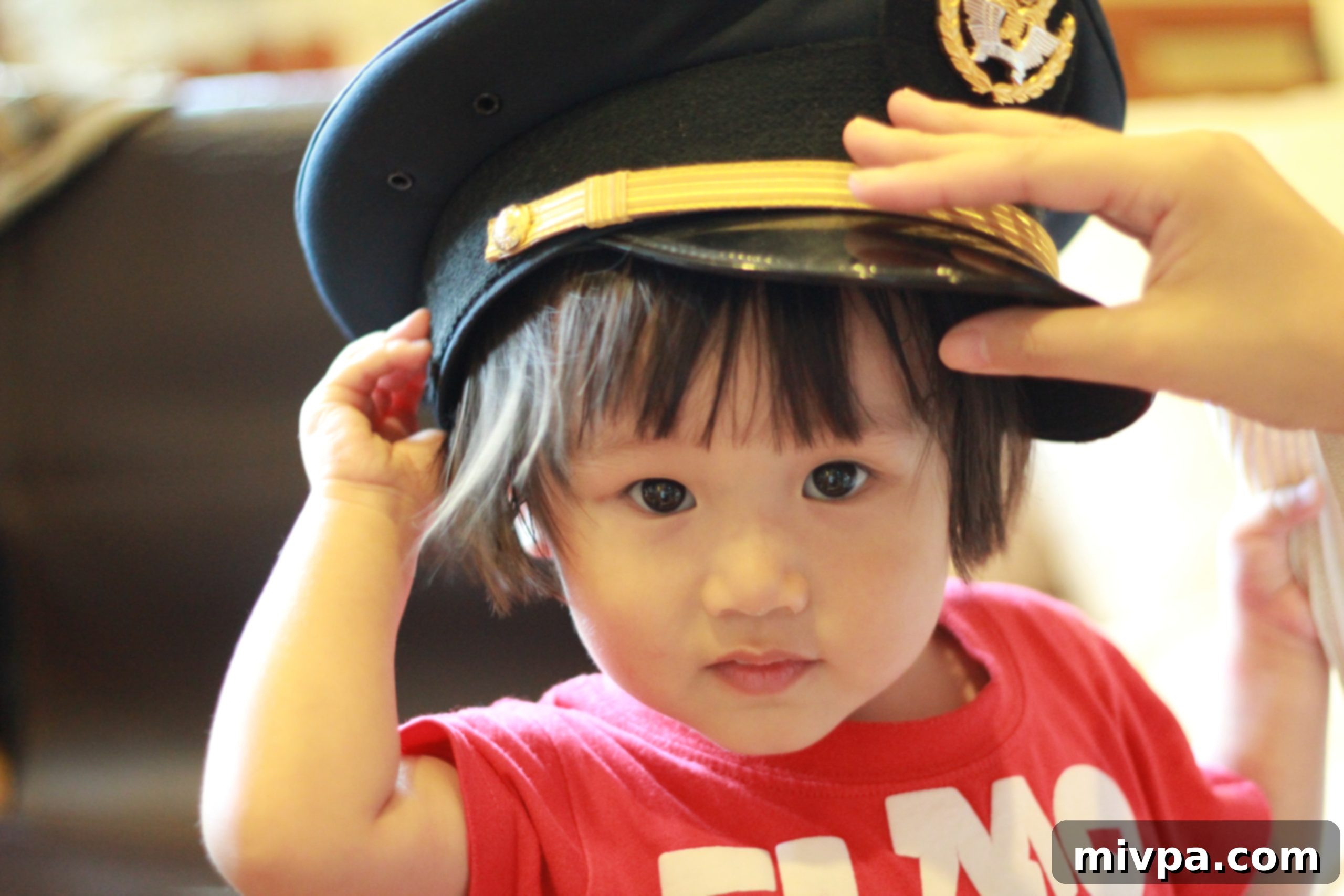
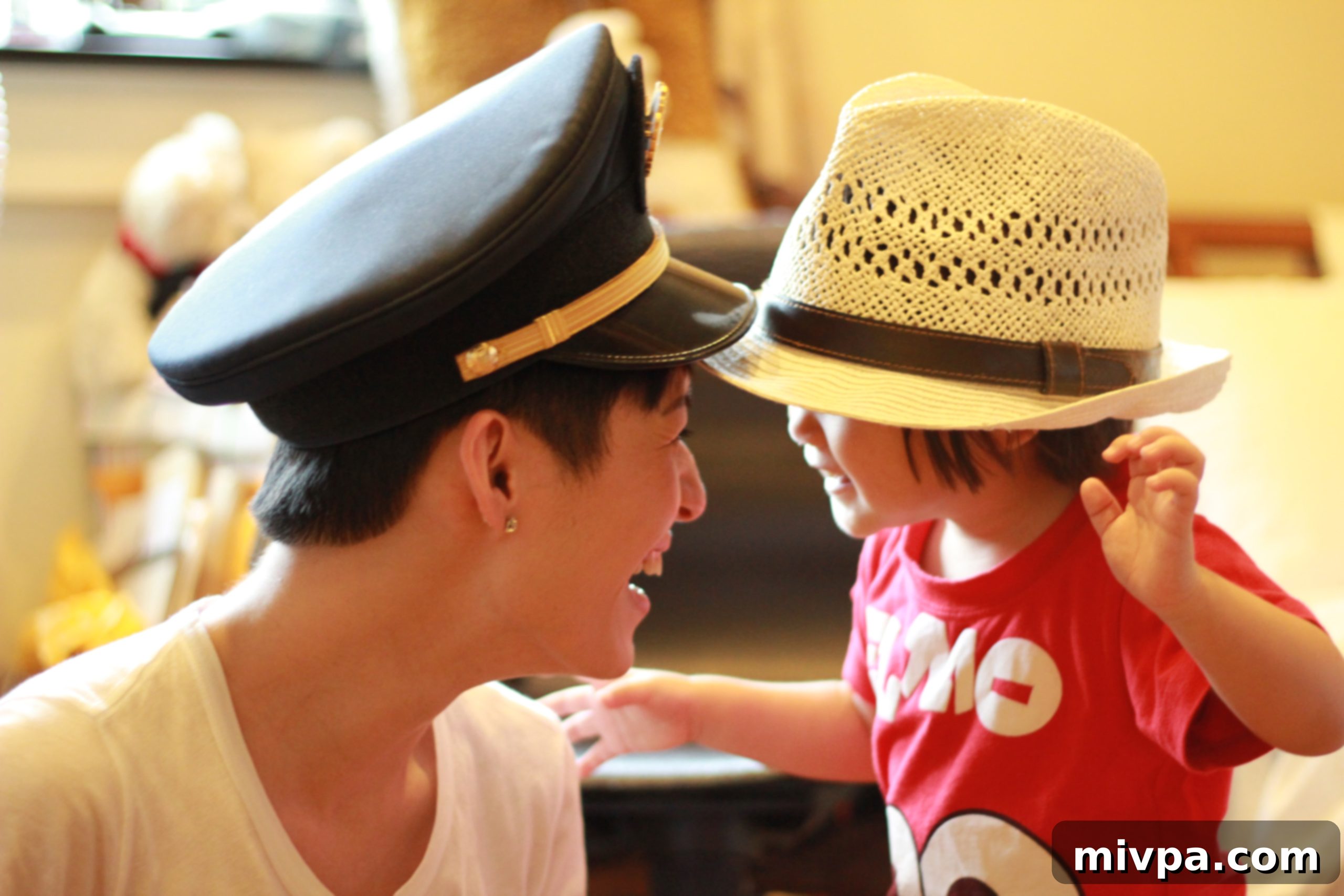

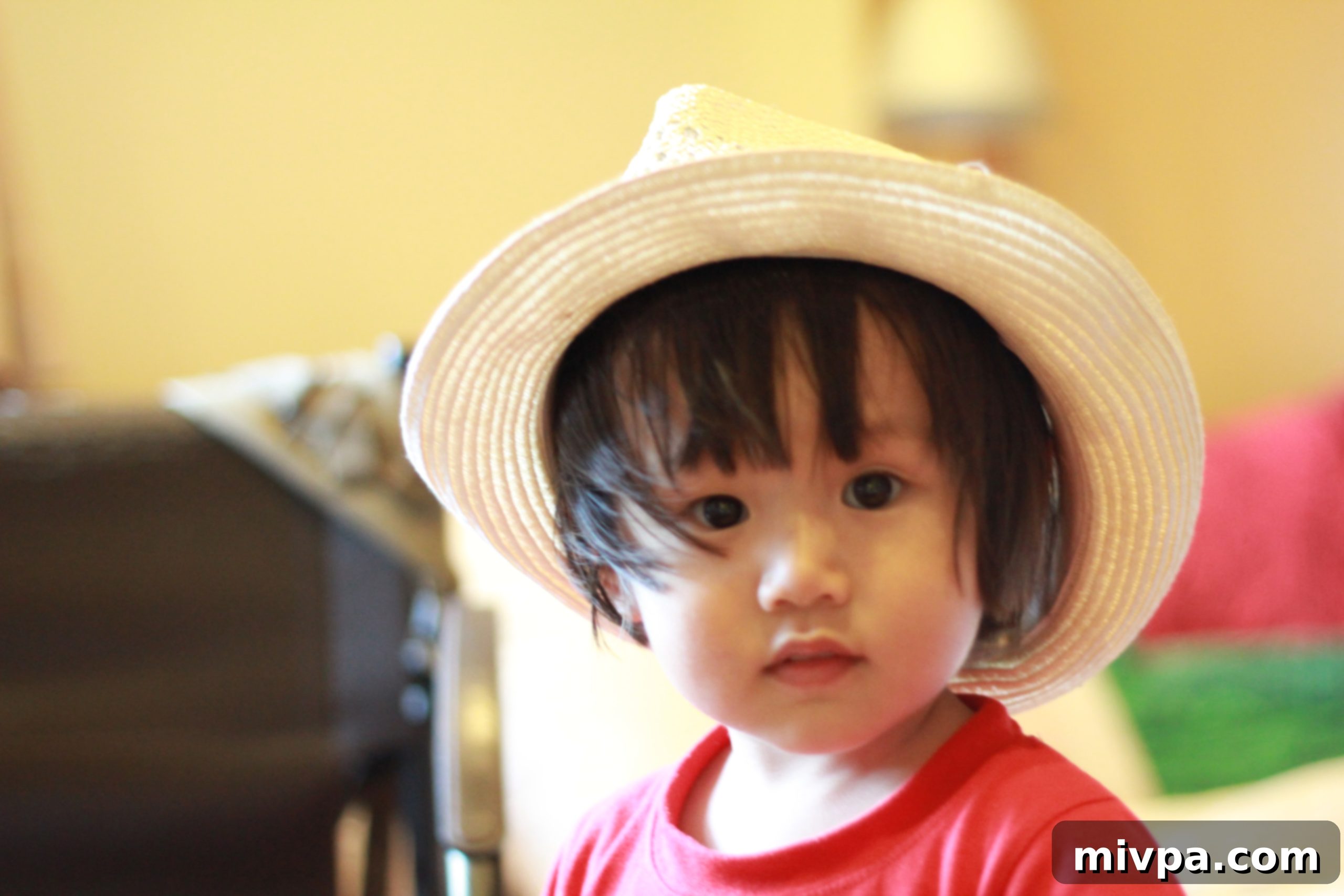
And just when we thought she couldn’t get any cuter, En Tong proceeded to charm us all over again. With a natural theatrical flair, she picked up her tiny hat and suitcase, then gracefully settled down at the piano, treating us to an utterly charming, improvised song. Her spontaneous performance was a heartwarming reminder of the simple joys and innocent wonders that family gatherings bring, truly making her the star of the night.
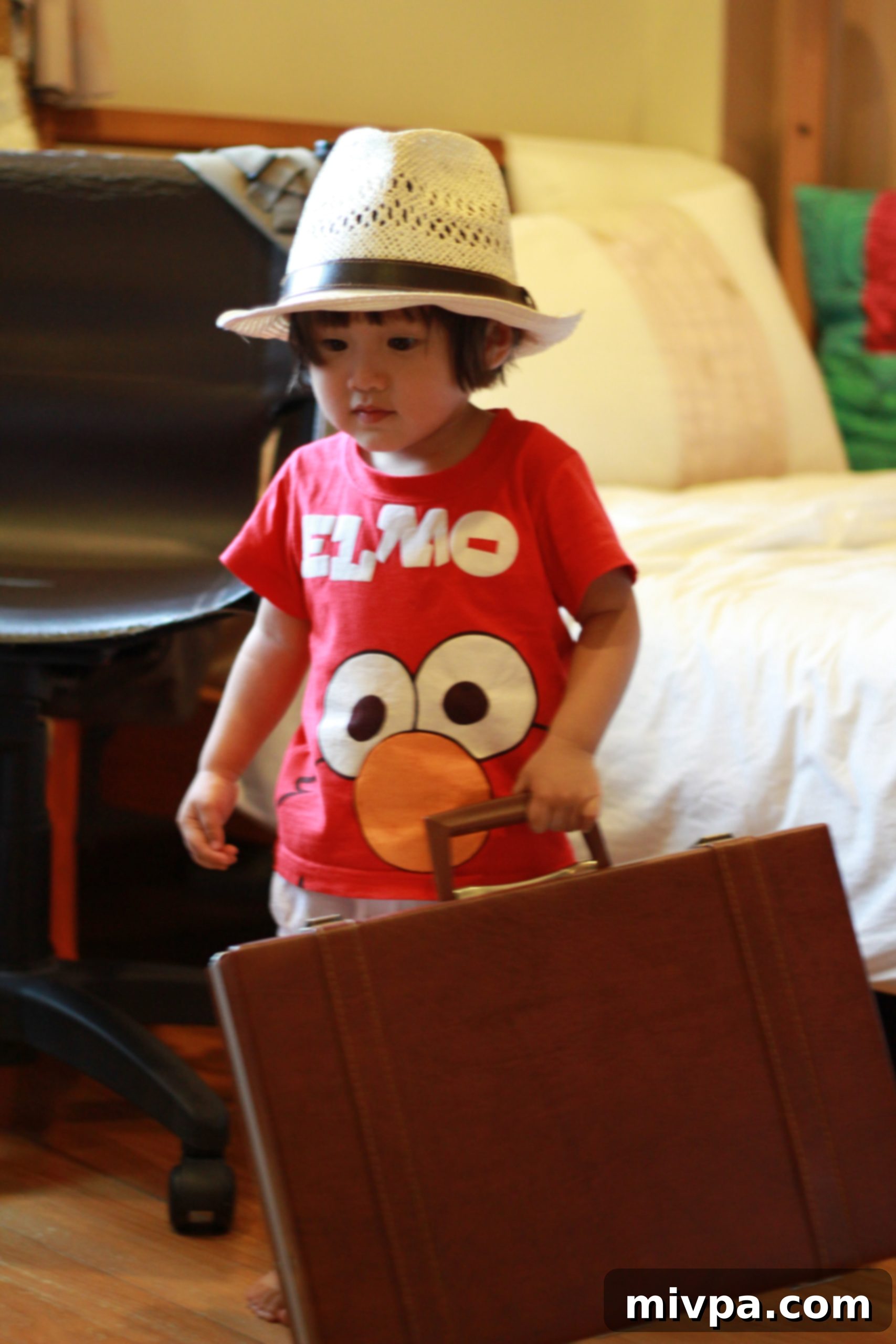
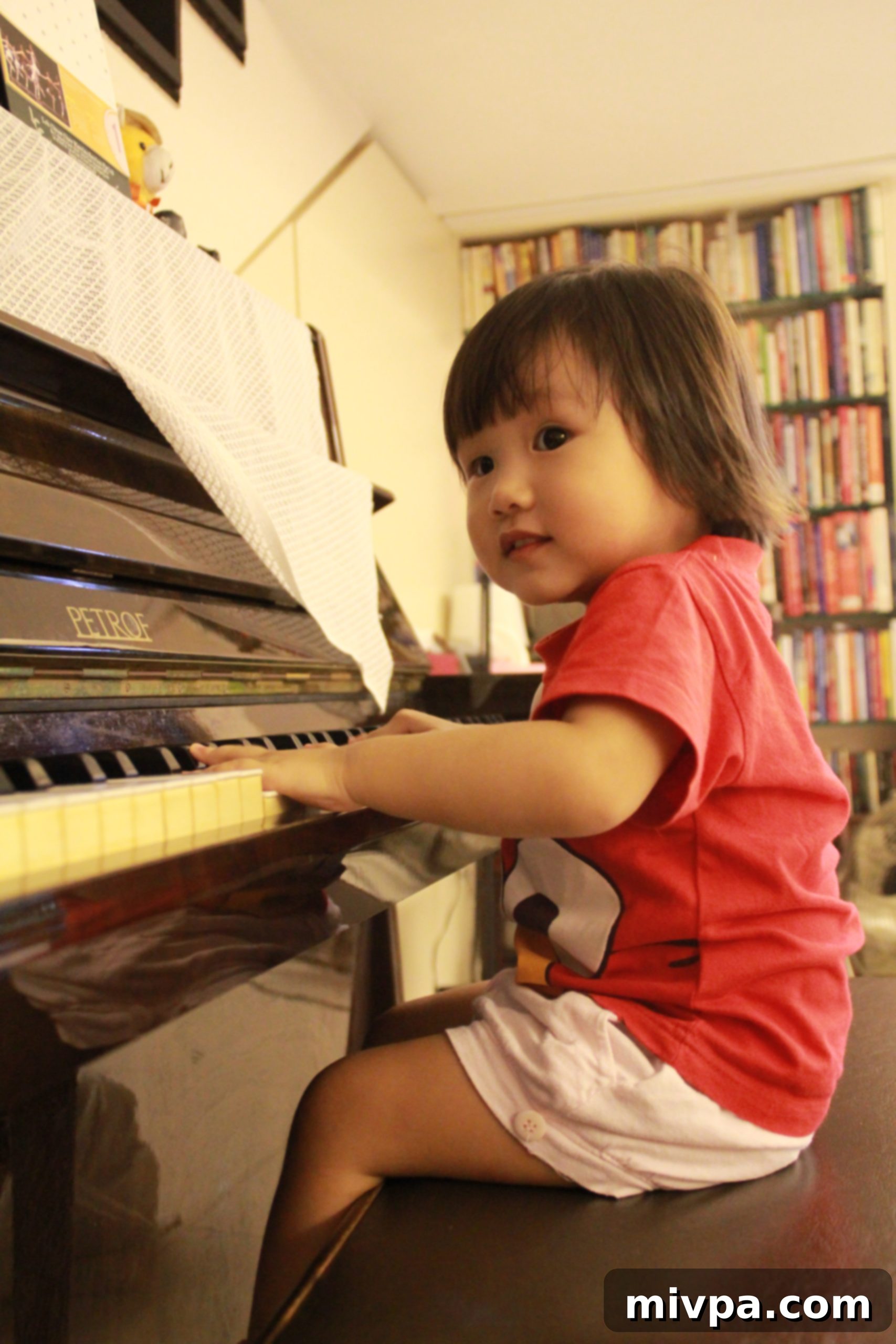
The Grand Feast: A Culinary Tapestry of Tradition and Abundance
Having sufficiently raved about my incredibly cute cousin, it’s time to shift our focus to the magnificent spread of food that awaited us. The dinner table was a sight to behold – an amazingly colorful tableau, literally crammed to the brim with an astonishing array of traditional dishes and fresh ingredients. There were bowls overflowing with meticulously chopped ingredients for the steamboat, a whole steamed Hainanese chicken glistening with flavorful juices, a perfectly roasted duck with crispy skin, and rich, savory soya sauce pig trotters, simmered to tender perfection. It was a true feast for the eyes before it became one for the palate, embodying the spirit of abundance and celebration that defines Chinese New Year.
Regrettably, in the flurry of activity and excitement, I didn’t manage to capture photographs of every dish, including my proud creations like the carrot cake, rosti, or the vibrant fruit salad. However, I can attest that they all turned out splendidly, adding their own unique textures and flavors to the grand culinary mosaic. The absence of a picture certainly did not diminish their deliciousness or the joy they brought to the table.
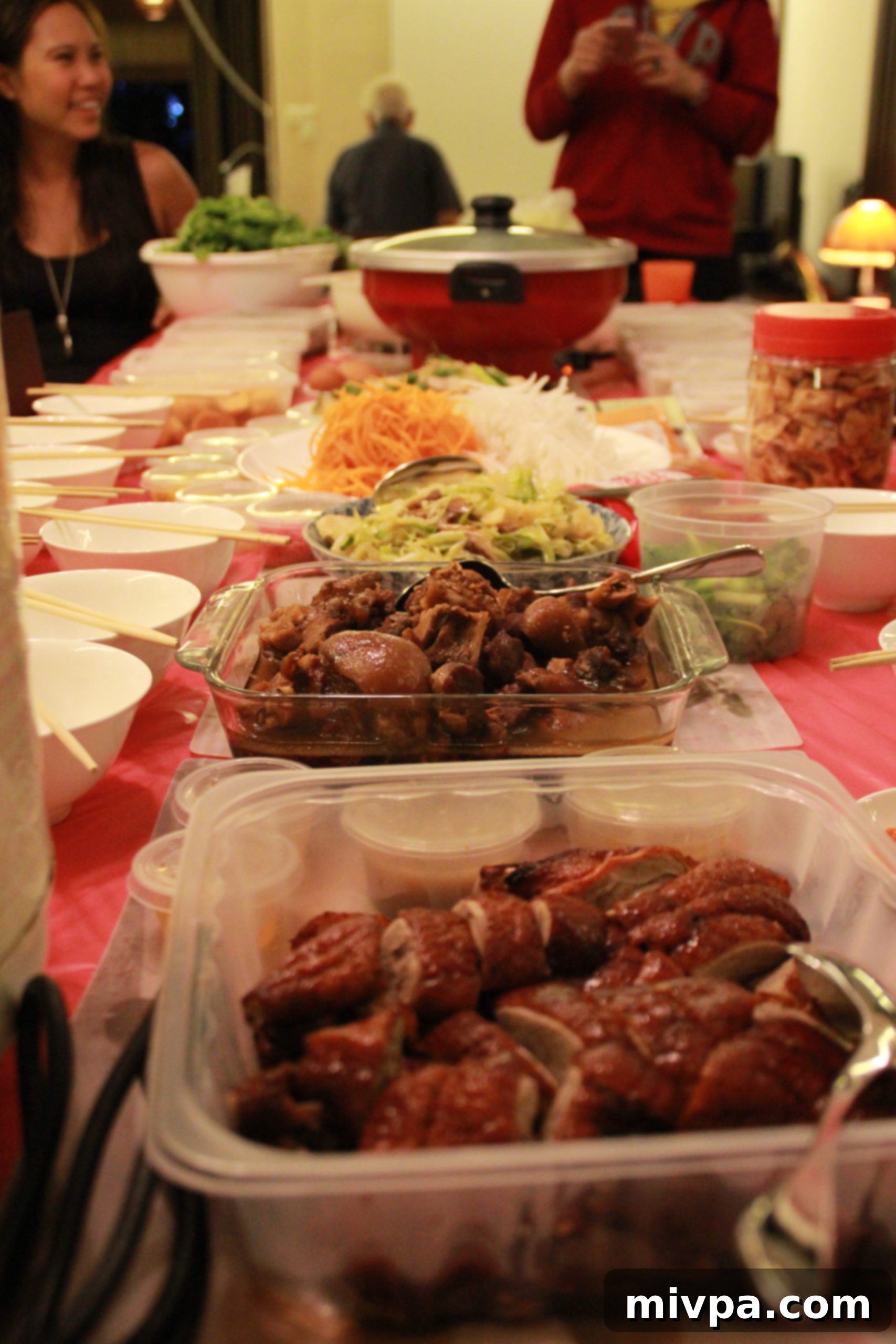
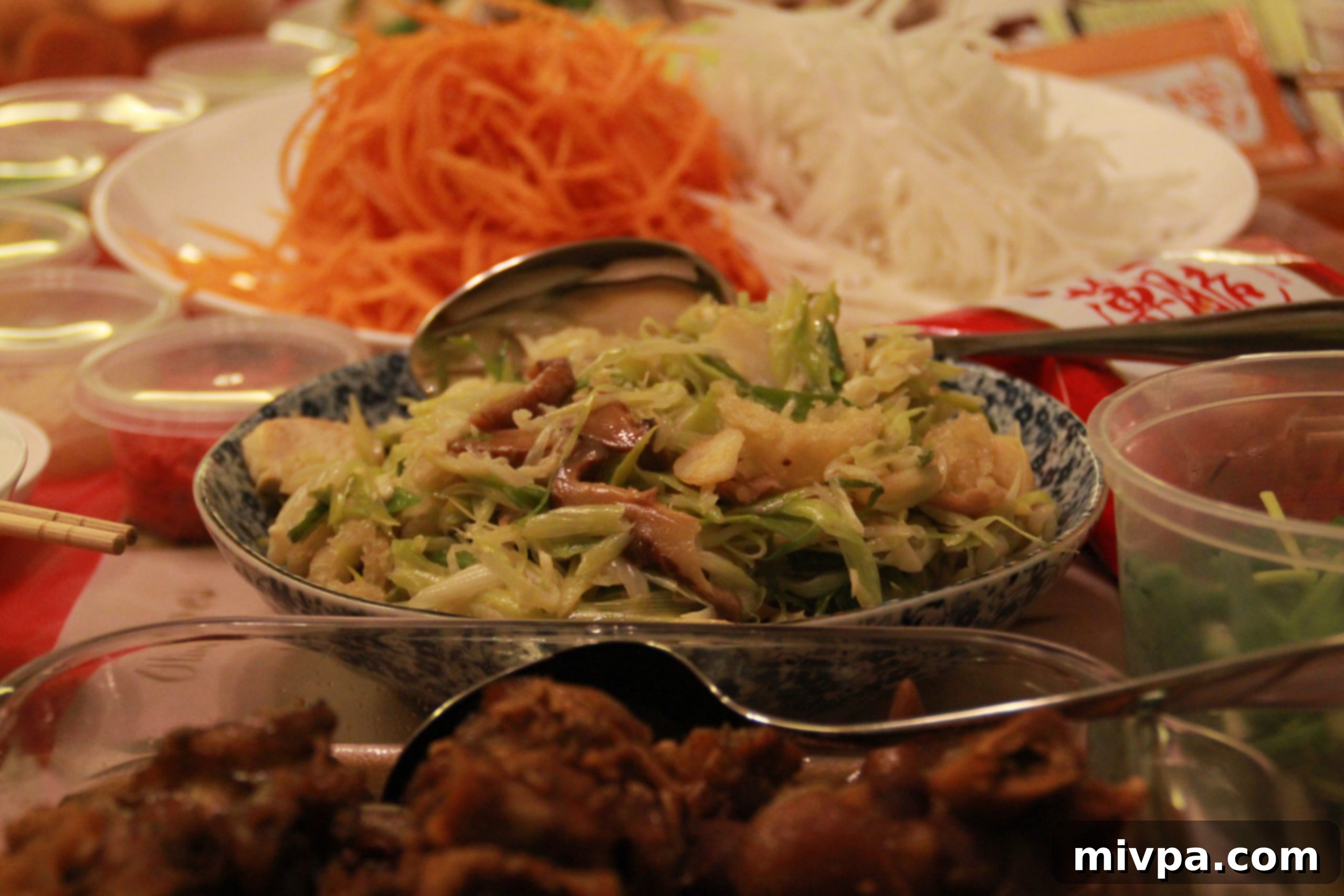
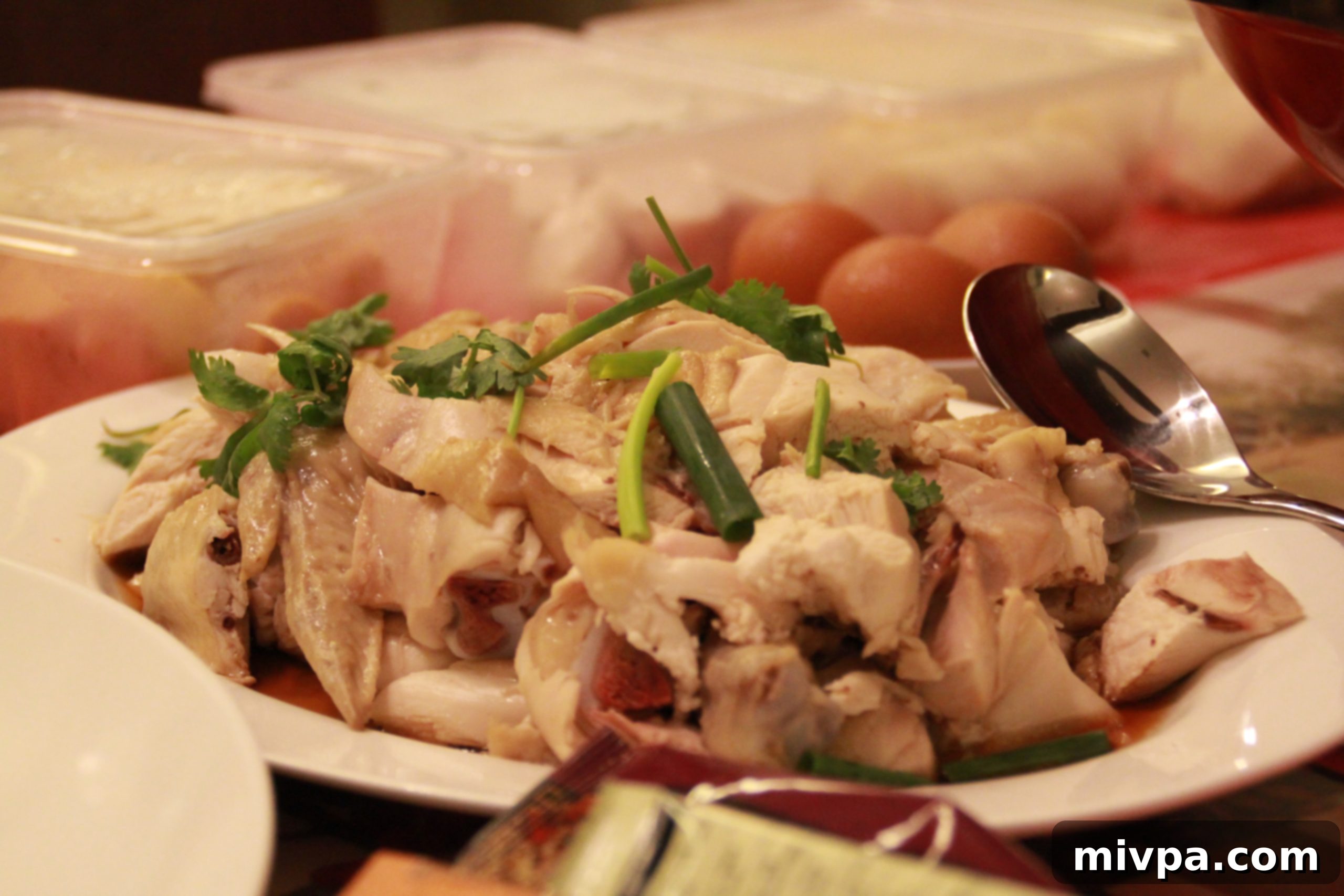
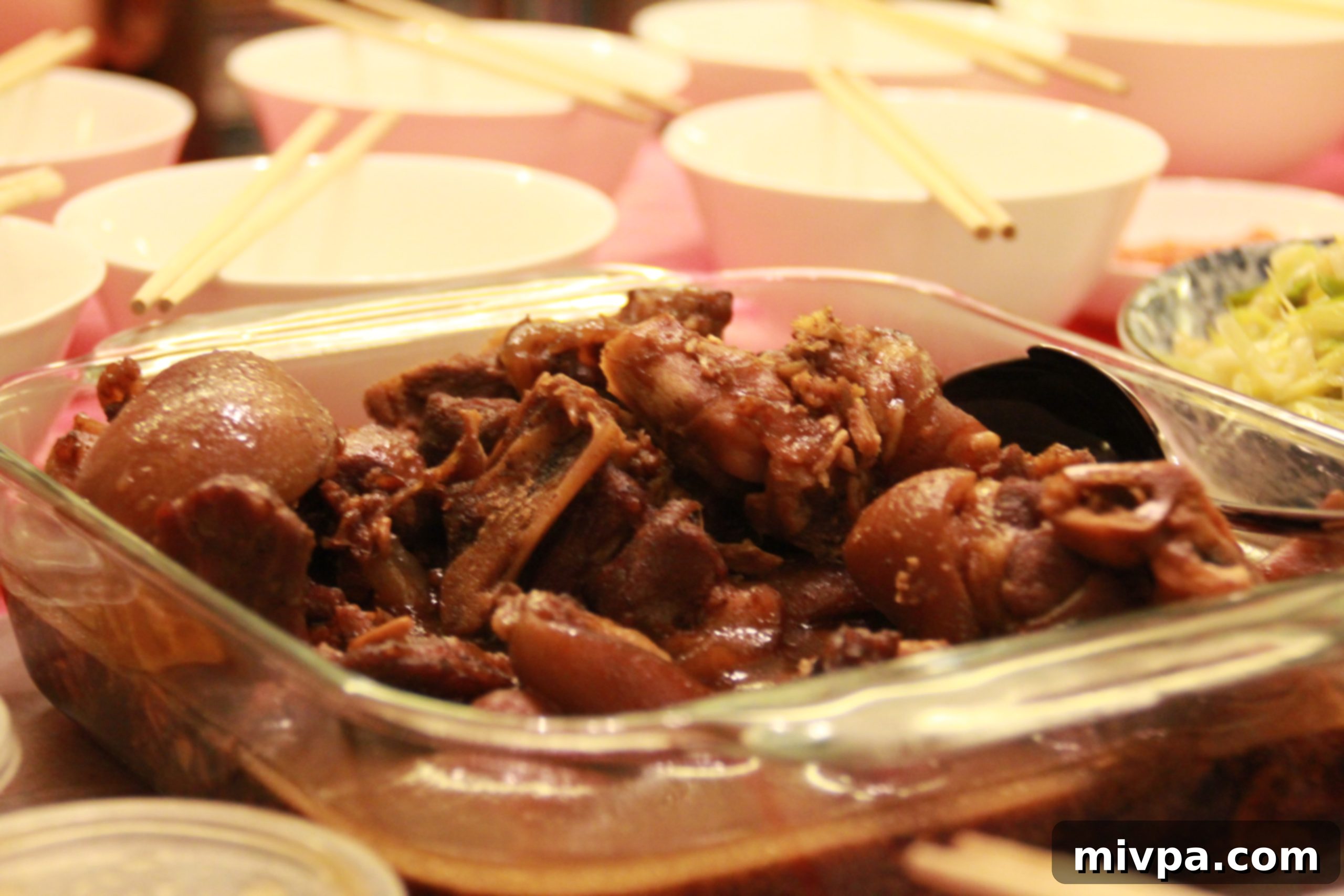
The Yu Sheng Ceremony: Tossing for Prosperity and Good Fortune
Dominating the center of the table, captivating our attention with its vivid hues, was the Yu Sheng. Its array of brightly colored ingredients promised a spectacle of tradition and hope. With synchronized frenzy and overflowing enthusiasm, we gathered around the dish, chopsticks poised, ready for the “Prosperity Toss.” Each high toss of the ingredients was accompanied by fervent wishes, all of us collectively hoping for a truly prosperous and abundant 2013, a year filled with good fortune, health, and success.
The Yu Sheng ceremony, known as “Lo Hei,” is far more than just mixing ingredients; it’s a symbolic act of ushering in good luck for the new year. Each step, each ingredient, and each utterance carries specific blessings and aspirations. According to popular tradition and as further elucidated by sources like Wikipedia, the person preparing the Yu Sheng guides the ritual, offering specific New Year greetings with the addition of each component, building anticipation and collective hope:
- The ceremony begins with an auspicious start. The first greetings offered are “Gong Xi Fa Cai” and “Wan Shi Ru Yi,” meaning “Congratulations for your wealth” and “May all your wishes be fulfilled.” These set the tone for a year of prosperity and contentment.
- Next, the delicate raw fish, typically salmon, is carefully added. This symbolizes abundance and excess throughout the year, with the phrase “Nian Nian You Yu” (年年有余). The word “fish” (鱼 yú) in Mandarin sounds similar to “abundance” (余 yú), making this a powerful and hopeful wish for continuous surplus.
- Slices of pomelo or lime are then scattered over the fish, infusing the dish with extra luck and auspicious value. The accompanying blessing, “Da Ji Da Li” (大吉大利), translates to “Good luck and smooth sailing,” signifying an unhindered journey through the year.
- A generous dash of pepper is sprinkled over the mixture, with the hopeful intention of attracting more money and valuables. This act is accompanied by the powerful greeting “Zhao Cai Jin Bao” (招财进宝), meaning “Attract wealth and treasures,” a direct wish for financial prosperity.
- Following the pepper, a stream of oil is poured over all the ingredients, forming continuous circles. This symbolizes encouraging money to flow in from all directions, encircling and enriching one’s life. Two significant phrases are uttered here: “Yi Ben Wan Li” (一本万利), which means “Make 10,000 times of profit with your capital,” and “Cai Yuan Guang Jin” (财源广进), signifying “Numerous sources of wealth,” pointing to diverse avenues of income.
- Brightly colored carrots are then added, indicating blessings of good luck and prosperity. The phrase “Hong Yun Dang Tou” (鸿运当头) is pronounced, meaning “Good luck is approaching” or “Good fortune is at hand,” bringing a vibrant promise for the future.
- The shredded green radish is introduced next, symbolizing eternal youth and vitality. With this, we wish “Qing Chun Chang Zhu” (青春常驻), which means “Forever young,” a blessing for enduring health and youthful spirit.
- Subsequently, the shredded white radish is added, a potent symbol for prosperity in business and promotions at work. Two phrases accompany this: “Feng Sheng Shui Qi” (风生水起), meaning “Progress at a fast pace,” and “Bu Bu Gao Sheng” (步步高升), meaning “Reaching higher levels with each step,” wishing for continuous advancement in career and ventures.
- Finally, the essential condiments are incorporated, each carrying its own blessing. First, peanut crumbs are dusted onto the dish, symbolizing a household filled with gold and silver. This wish is encapsulated in “Jin Yin Man Wu” (金银满屋), meaning “Household filled with gold and silver,” a desire for material abundance within the home.
- Sesame seeds quickly follow, representing a flourishing business and a thriving enterprise. The accompanying phrase is “Sheng Yi Xing Long” (生意兴隆), meaning “Prosperity for the business,” an important wish for entrepreneurs and business owners.
- Last but not least, deep-fried flour crisps, often shaped like golden pillows, are added. These golden crisps carry the wish that literally the entire floor would be filled with gold, symbolizing overwhelming wealth. The greeting “Man Di Huang Jin” (满地黄金) means “Floor full of gold,” a vivid and enthusiastic wish for boundless riches.
The entire process is a lively, communal affair, with everyone actively participating, shouting auspicious phrases, and striving to toss the ingredients as high as possible – believing that the higher the toss, the greater the prosperity in the coming year. It’s a beautiful, noisy, and utterly joyous ritual that perfectly encapsulates the optimism and hope of Chinese New Year.
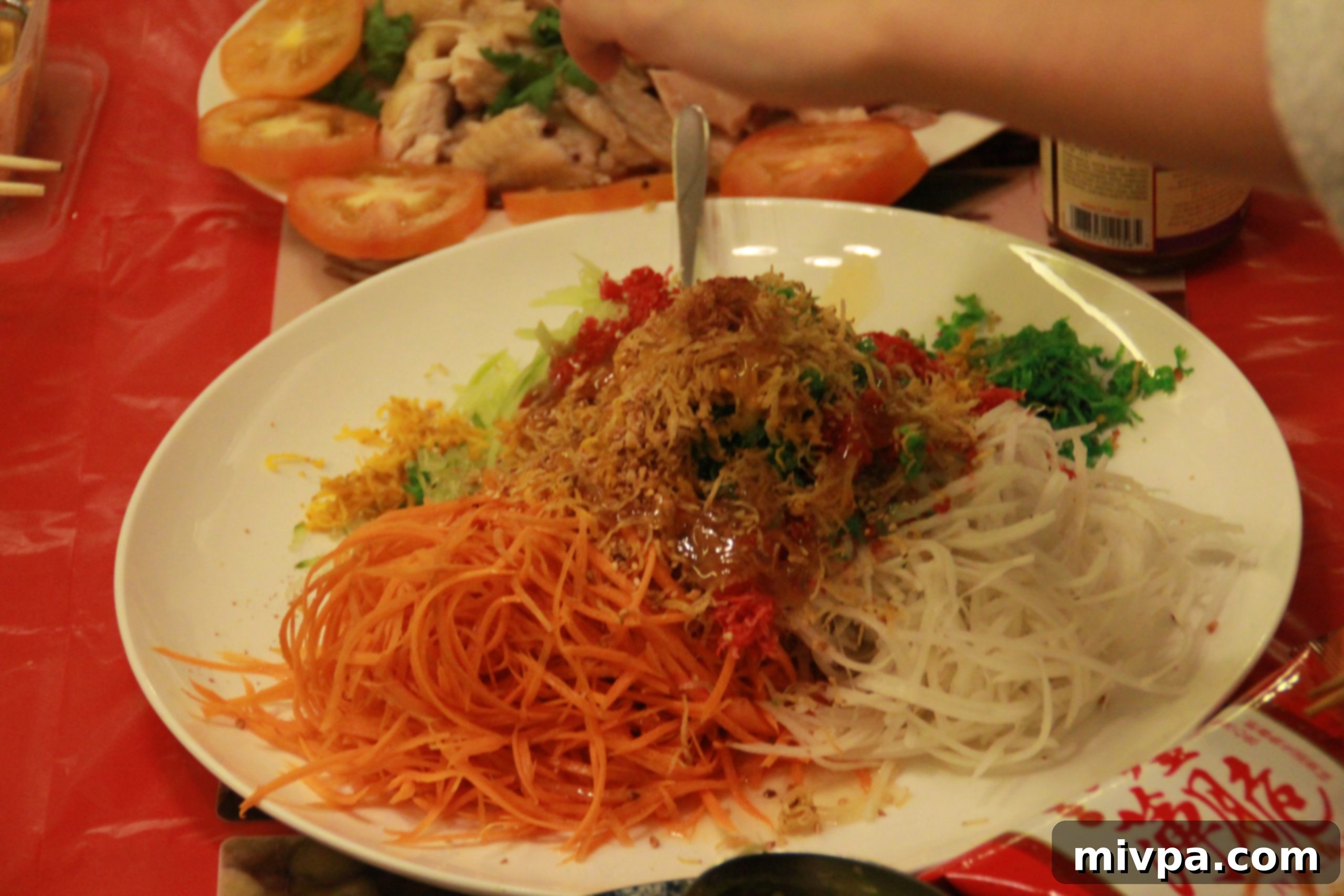
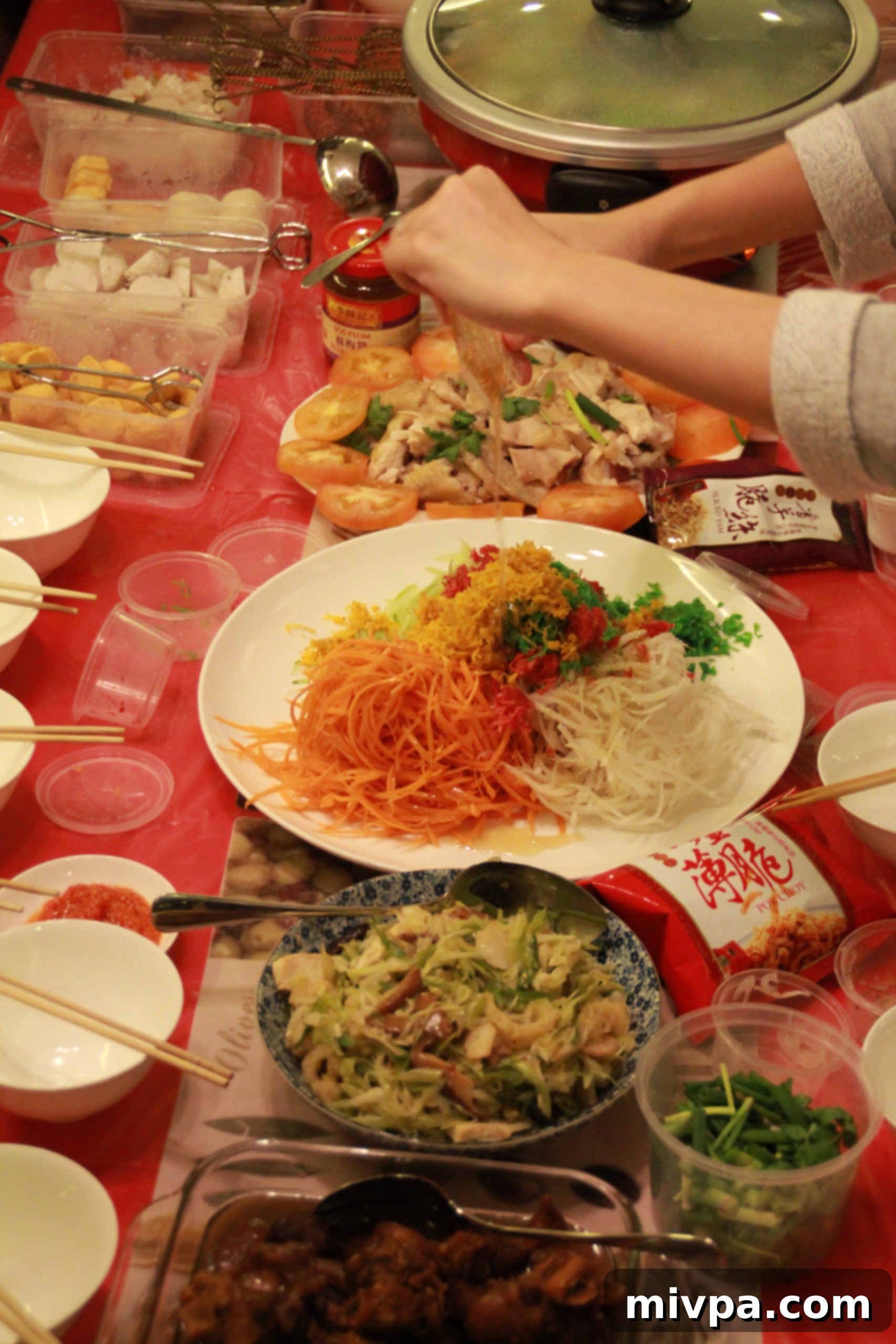
Wishing You Prosperity in the Year of the Snake!
As the laughter subsided and the last morsels of the feast were savored, a profound sense of warmth and contentment enveloped us all. This reunion dinner was more than just a meal; it was a vibrant celebration of family, culture, and the enduring power of tradition. It reinforced the bonds that tie us together, reminding us of our shared heritage and the collective aspirations we hold for the future. The experience of cooking for my family, of witnessing their joy, and participating in these cherished rituals was an unforgettable highlight, strengthening my connection to my roots in Singapore.
May this spirit of joy, unity, and prosperity extend to everyone. Happy Chinese New Year of the Snake to you all!
